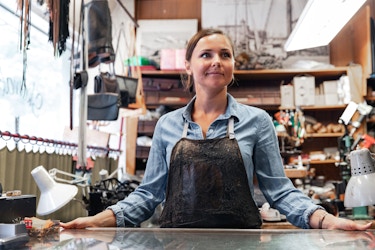
Handmade is hot. If you want to craft a business, the marketing must begin once the making is done. Here are five ways to start marketing your handmade business.
Establish your brand
Developing your brand identity is separate from marketing, but essential to it. Branding is about telling the world who you are and what your business is all about. According to Neil Patel, marketer, influencer and co-founder of NP Digital, while it may be represented by logos, fonts and colors, your brand is ultimately about personality. Marketing, Patel says, is about communicating your brand to the wider world.
It’s also about delivering the right message to the right customer, which starts with something as basic as self-identification. Donna Maria, author, entrepreneur and founder of the Indie Business Network (IBN), works with entrepreneurs who use descriptors such as "artisan-made," "small-batch" and "handcrafted." A detail as seemingly insignificant as the difference between handmade and homemade can be key to establishing a reputable, professional brand, she told CO—.
[Read more: Branding Your Business for Every Stage of Growth]
Identify your customer
As long as you are a truly handmade business, not everyone can be your customer. Even the most scaled-up handmade producers have limits and, according to IBN’s Donna Maria, that’s okay. “You cannot and should not be all things to all people,” she said. Instead, “[f]ind a piece of the market that is underserved and make ‘the’ product for that market and that market only.” Future expansion, she points out, is always a possibility.
Consider the “why” of your business. If your products address a specific problem, then your target audience is people facing that problem—or more likely a percentage of them. The percentage interested inorganic ingredients or sustainable packaging or energy-efficient techniques—whatever your differentiator is.
Choose the right sales venue
Not every sales platform is right for every brand or product. For practical purposes—listing fees, inventory management, time constraints—it makes sense to start where your target customer is most likely to shop.
- Etsy, with over 60 million buyers in 2020 alone, is the first stop for many lovers of handcrafted goods. In addition to its highly visible advertising campaigns attracting customers to the site, Etsy advertises makers’ products on Facebook, Instagram and Pinterest—a service they charge for if a sale is made.
- Amazon Handmade is, well, Amazon, where a large portion of the buying public starts every product search. Artisans pay a 15% referral fee for the potential of reaching 250 million shoppers. If your target demographic includes people who didn’t know they wanted a small-batch product but are open to buying it once the world’s largest retailer has served it up, Amazon Handmade could be the way to capture them.
- There are, in fact, a lot of e-commerce options where your particular product may both fit in and stand out. As you research the likes of Big Cartel, Artfire and eCrater, consider not only the fees and potential traffic but how well they mesh with your brand.
- Don’t forget brick-and-mortar. Some consumers want to meet products face-to-face. Perhaps they want to smell the fragrance or feel the fabric. If that sounds like your product and opening your own shop isn’t an option, consider craft fairs or pop-up locations. For consumers in search of both handmade and local, nothing can beat discovering your products in a local shop, perhaps through a consignment arrangement.
You cannot and should not be all things to all people.
Donna Maria, founder of the Indie Business Network
Take full advantage of social media
In addition to the standard best practices—leveraging hashtags, producing high-quality photography, maintaining consistency—handmade businesses have a unique social media opportunity called “process.” Consumers who covet handmade goods (aka your target customer) love to watch how it’s done. Whether it’s a how-to tutorial or a 10x speed video set to music and played on a loop, the process will speak to consumers. Instagram is perfect for this. Be sure to reply to followers’ questions about process and materials, as each interaction makes you more of an expert and builds your brand.
Post about your work in progress (#wip). Post about sourcing raw materials. Post about posting your items for sale. Post about shipping your product. It all makes followers feel like they are in the know and makes you feel like an acquaintance rather than a company.
[Read more: Five Easy Ways to Use Social Media to Promote Your Business]
Stay relevant but be genuine
As the owner of a handmade business, you decide what products to make and how to make them. To remain relevant, you should be prepared to adjust and adapt. Stay on top of trends, be they broad and likely to stick around—sustainability and inclusion, for example—or narrower, shorter-term trends like the hot new color or footwear style.
If you stay alert, a lot of what’s happening around you can be mined for emerging trends. Watch television, read magazines, scan your news feed and people-watch like a marketer.
Relevance, however, should not come at the cost of authenticity, which Forbes labels as crucial for today’s savvy marketers. The negative impact of inauthenticity can easily outweigh any benefit you receive from appearing to be cutting edge. Be aware of what’s trending, latch onto what genuinely fits and incorporate it into your marketing.
CO— aims to bring you inspiration from leading respected experts. However, before making any business decision, you should consult a professional who can advise you based on your individual situation.
Follow us on Instagram for more expert tips & business owners’ stories.
CO—is committed to helping you start, run and grow your small business. Learn more about the benefits of small business membership in the U.S. Chamber of Commerce, here.
Join us for our Small Business Day event!
Join us at our next event on Wednesday, May 1, at 12:00 p.m., where we’ll be kicking off Small Business Month alongside business experts and entrepreneurs. Register to attend in person at our Washington, D.C., headquarters, or join us virtually!








